At nightfall on the day after Christmas in 2015, a killer tornado ripped a 13-mile track through the Texas towns of Sunnyvale, Garland, and Rowlett, killing 10 people. Based on the wind damage to structures and vegetation, authorities rated the twister an EF-4 on the Enhanced Fujita scale—the strongest tornado in history for December in Texas. That EF-4 rating corresponds to wind speeds between 166 and 200 mph; according to a National Weather Service estimate, the Garland-Rowlett tornado winds topped out at 170 to 180 mph.
But experts determined that only a few locations along the storm’s track saw that kind of wind power. For most of the tornado’s path, destruction reflected much lower wind speeds—primarily EF-0 or EF-1 levels of damage (corresponding to winds of 65 to 100 mph), with some zones of EF-2 and EF-3 destruction (corresponding to winds of 111 to 165 mph).
In the days after the storm, engineers from APA – The Engineered Wood Association toured the affected area to draw lessons for the construction industry. The team’s report on the aftermath, “Texas Tornado Damage Assessment Report,” is posted on the APA’s website (apawood.org). Photos in this story are drawn from that report.
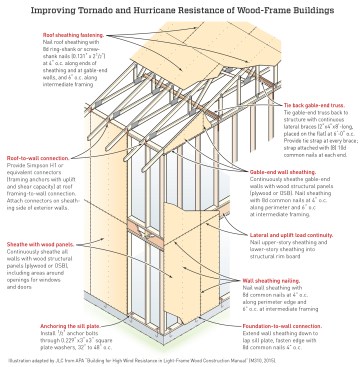
Tim Healey
After inspecting hundreds of damaged or destroyed homes in multiple storm events in many different locations in the United States, APA engineers have concluded that a systematic upgrade of the component and assembly connections, designed to create a functioning load path for wind resistance throughout the structure, could save many homes at a reasonable cost.
APA engineer Mary Uher was on site with the damage assessment team. For Uher, the work is personal; she was born and raised in the heart of Tornado Alley, and family members still live there. As she said to JLC, “Tornadoes are a real-life thing to me.”
Educating builders and remodelers is part of Uher’s mission with APA. “I hear a lot of people say, ‘You just can’t design for a tornado,’” she says. “But it’s not true. On the shoulders of this tornado, where we saw a significant portion of the damage shown in these pictures, the wind speeds during the storm were right at code wind speeds, or just a little bit above. And you can design to save those homes, or to experience less damage.”
To survive high winds, a house needs a continuous load path; wind forces on the roof and walls have to be transmitted through those structures into the foundation below (see Improving Tornado and Hurricane Resistance of Wood-Frame Buildings, page 41). “A chain is only as strong as its weakest link,” Uher says. “So you have to have your sheathing attached to your roof supports properly, your roof supports attached to your wall properly, your wall properly framed and sheathed and nailed to transfer the loads between the walls and the floor. You have to have your floors connected together properly, your floors connected to your foundation properly, and then your foundation has to be properly sized. And wherever the weakest link is, that’s where the failure will occur. That doesn’t mean everything else is strong enough; it simply means that the load has found the weakest link in the chain.”
Photos in the APA report show examples of failure at all these connection points—even in homes at the storm’s edge, where damage to surrounding structures and vegetation was not extreme. In many cases, better construction could have saved homes.
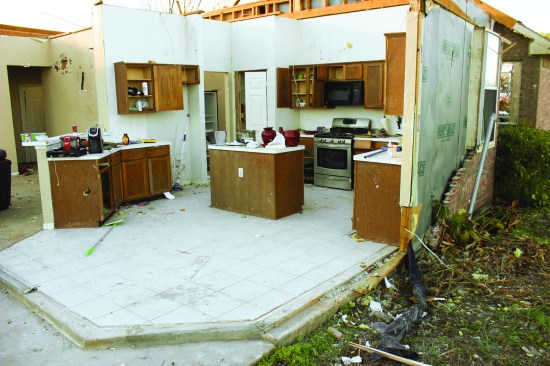
This kitchen wall was not fastened down with anchor bolts, but only with powder-actuated nails.
Wall Anchoring Failure
APA’s 2015 design guide, “Building for High Wind Resistance in Light Frame Wood Construction,” recommends that wall sills be attached to foundations using anchor bolts spaced at 32 inches to 48 inches o.c., connected with nuts over 3-inch washers. The guide calls for walls to be fully sheathed with wood structural panels (OSB or plywood), attached with 8d nails at 6 inches o.c. in the field and at 4 inches o.c. on the edges (including at the sill plate).
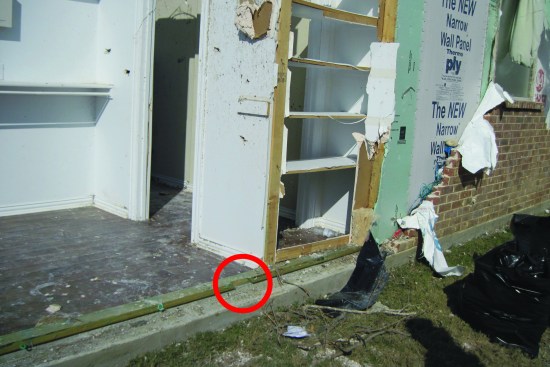
Nails used to fasten another detached wall plate do not appear to have penetrated the concrete when the plate was installed.
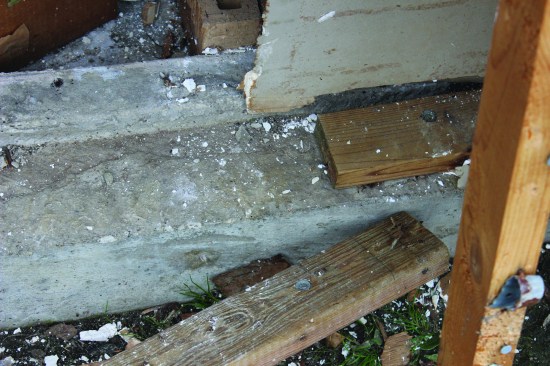
The wall plate stayed in place, but the wall above it came loose; the fastening of laminated fiber or foam sheathing was insufficient to hold the wall studs in place.
The 3-inch washers, Uher explains, help to prevent cross-grain bending of the sill plate, as well as preventing the sill plate from lifting off the foundation. In Texas, however, the APA team found many examples where anchor bolts weren’t even used—just powder-actuated nails (which didn’t always penetrate the concrete).
But even where sill plates were firmly attached to the foundation, says Uher, carpenters often neglected to nail the wall sheathing to the plate. That step is important, Uher says: “It really finalizes that connection.”
Sheathing and Cladding Failure
In any kind of high-wind event—a hurricane, a tornado, or even a strong thunderstorm—wind applies pressure on the upwind side of the building, and suction on the downwind side. And while the public perceives brick walls as strong and durable, brick veneer cladding on houses typically is not designed or intended to resist these lateral forces of wind. Instead, that job is done by the wood framing of the house walls and by the bracing on those walls. The brick has to be attached to the wood-framed walls, and those sheathed stud walls have to pick up the wind forces on the house and transmit them into the foundation—without excessive flexing or racking.
“It’s another homeowner misconception,” says Uher. “People think, ‘My house is brick, it’s strong.’ That’s what the three little pigs taught us. But the brick isn’t really what’s holding your house up.”

Failure of brick veneer exposed to relatively moderate wind speeds was common on the fringes of the tornado’s track.

Vertical cracking in the brick at the corners of buildings was a typical failure—the result of lateral displacement, or “drift,” of stud walls built without sufficient bracing.
The images above show big cracks at wall corners. “We saw this repeated over and over again in Texas,” says Uher. “We think that it is due to lateral displacement. Brick is really brittle, and the lack of flexibility of brick can be a problem in these high wind speeds.” Structural wall bracing is important to maintain stiffness so that inflexible components such as brick cladding, doors, and windows will not be damaged by “drift” of the wall structure.

In one case, brick veneer and foil-faced foam sheathing were both blown off the gable wall—possibly after the wind breached the garage door.
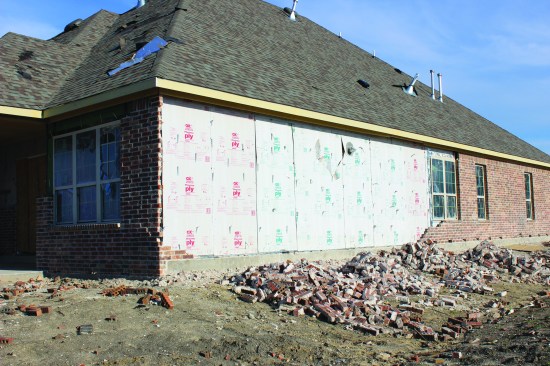
In another example, portions of a brick wall collapsed. “Lateral flexibility within these structures is incompatible with rigid and brittle brick-veneer wall coverings,” notes the APA report.
Attachment of the brick cladding to the framed wall can also be a factor. The destructive wind action “was likely suction,” says Uher. “There were brick ties installed on the sheathing, but they were never installed into the brick. So somebody knew the code, and knew to put the brick ties on, but then they didn’t embed them into the mortar.”
APA recommends fully sheathing walls with wood structural panels (plywood or OSB), as backup protection for the building and contents in case cladding is lost. APA’s “Building for High Wind Resistance” guide notes, “The minute the siding is blown off the wall, the remainder of the wall left behind must be able to protect the contents of the structure from the wind and rain by itself.”
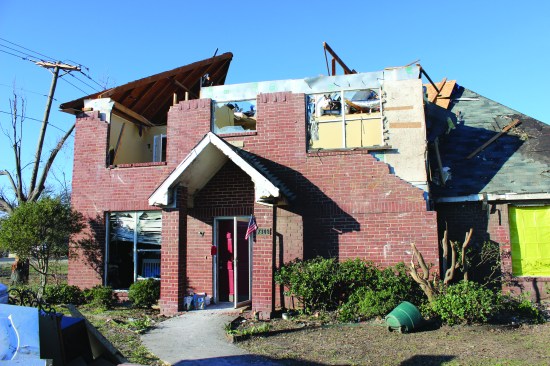
In the Garland-Rowlett tornado, homes suffered complete loss of the roof structure because wall plates weren’t tied to walls with well-nailed structural sheathing, or roof members weren’t securely fastened to wall plates.
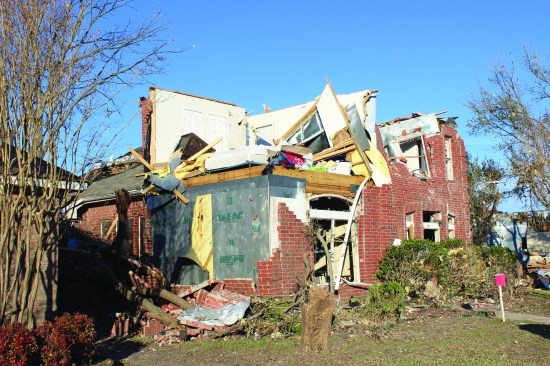
In other cases, inadequate connections between upper and lower stories resulted in the destruction of upper stories.
Tall Wall Failure
Unusual architectural features can create special weaknesses in a wood-framed wall. In the Garland-Rowlett tornado, the APA team noticed a few cases where failure occurred because two-story walls weren’t adequately braced or supported against lateral loads.
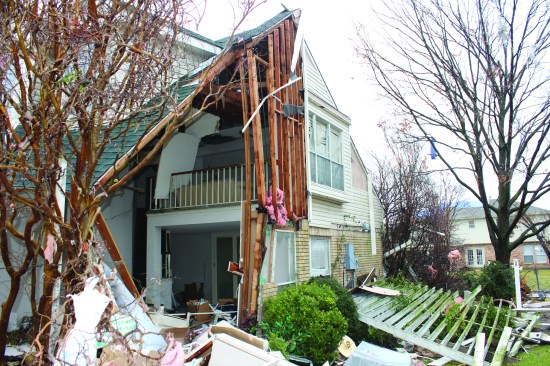
Inadequate bracing of tall walls …
In one case (above), the wall for a two-story open space with a cathedral ceiling was framed as two walls, with a mid-height wall plate creating a “hinge” halfway up the wall. “Walls such as this should be designed using balloon framing or some other means of laterally bracing the wall,” says APA.
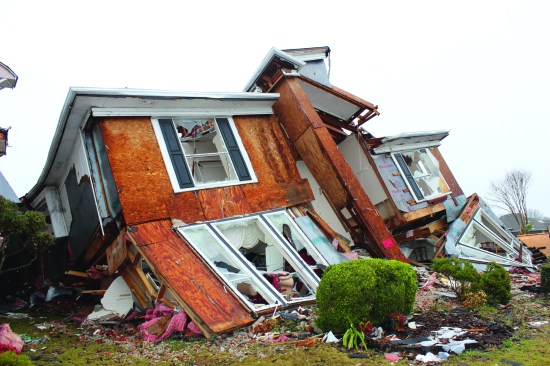
… and lower-story walls with multiple openings also resulted in structural failures.
In another example (above), first-story walls with extensive window and door openings had intermittent wood structural panel sheathing, infilled with laminated fiber sheathing. The first-story walls collapsed completely. The many openings “should signal the designer to pay special attention to the wall bracing specified in the building code for lateral resistance,” says APA. “Collapses such as this obviously represent a serious life-safety issue.”
Wall-to-Roof Connection Failure
When carpenters frame a house, we start at the bottom—and we think mostly about the problem of holding the house up. But when wind tries to tear a house apart, it generally works from the top down. As the winds pass over a peaked roof, wind suction tends to pull roof sheathing upward. This uplift force is transmitted into the rafters or trusses, which then pull up on the top plate of the wall.
In the Garland-Rowlett tornado, that wind force pulled some roofs off their walls. Touring the damage zone, APA engineers noticed that the connection of walls to roof was often insufficient. Roof framing wasn’t typically tied down to wall plates with metal connectors, and wall sheathing often didn’t overlap wall top plates.
In high-wind events, the roof-to-wall connection is subject to shear as well as uplift loads, notes the “Building for High Wind Resistance” manual. APA recommends framing connectors that can handle both kinds of loading, attached on the outside of the wall. Sheathing should overlap the plate, with nails at 4 inches o.c.
Attached Garage Failure
Attached garages can be risky in more than one way. Garage door openings typically leave only a small length of wall flanking the door, which makes it hard to brace the wall adequately.
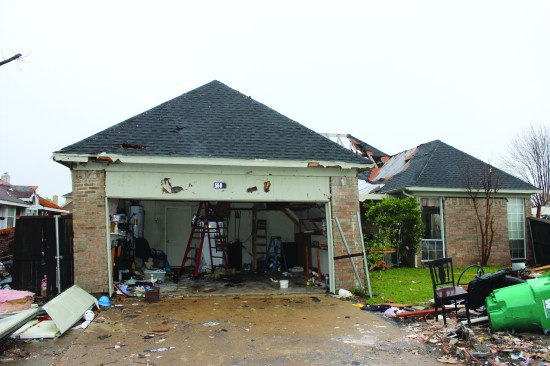
This garage door opening shows a classic racking failure that is also commonly seen in earthquakes.
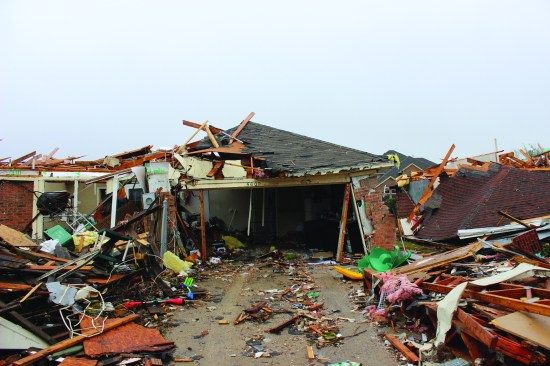
Similar racking of this garage door frame, plus catastrophic failure of the adjacent walls and roof—likely a result of the sudden pressurization of the building when the garage door was lost.
One code-allowed solution is to use a “portal frame” as prescribed in the International Residential Code (IRC), with a continuous header across the large opening, and heavily nailed wood structural panels tying the wall framing to the header—plus metal anchors tying the wall base to the foundation. (For more, see “The Portal Frame Option,” Aug/17)
But the garage door itself can also be a weak point. “Failure of a garage door pressurizes the inside of the house,” explains Uher. “Once the garage doors go, the wind is now not only on the outside of your house, but inside. You have suction on the roof, plus pressure from underneath. The pressures double, essentially—and then it’s typically a sudden failure of the roof.” One weak link can be the connection of the wall to the roof. “If that fails,” Uher says, “it allows both your walls to fall out and your roof to blow off.”
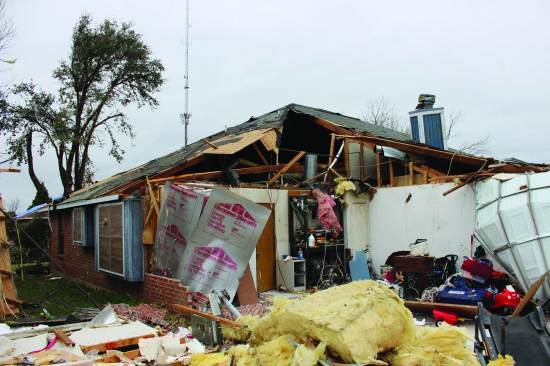
Pressurization of the garage apparently contributed sufficient force …

… and caused the loss of roof sheathing in nearby areas of the main house roof.
The Building Code—and Beyond
The lessons of the Garland-Rowlett tornado are twofold, says Uher. Some homes were damaged or destroyed because they fell short of code requirements. But some homes that failed did meet code. Of those homes, APA says, many could have been strengthened enough to withstand the winds, and for a modest cost. APA’s above-code “Building for High Wind Resistance” manual requires only a few modifications (called out in the illustration)—but these could make the difference between destruction and survival.
“Designing to code is important,” says Uher. “However, for my family, who live in Tornado Alley, if, as a rough estimate, they can spend an extra $1,000 to make their house safer (depending on the size and location), just to be a little more sure that it’s going to stand up when the tornado comes through—that’s worth it, in my eyes. It’s a lot easier than dealing with your house blowing down.”
